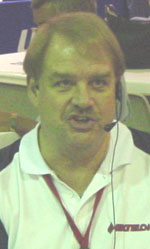
July - August 2003
Vol. 14, No. 4 | Contents
What's the Call?
by Otto Dietrich
National Rules Commissioner
 “I’m back!” Over the past five years that I’ve been the USRA’s Board President, Rich Clay has served as the National Rules Commissioner. But when other commitments made Rich’s continuing on in that role rather difficult, I immediately offered to resume that duty, after having held the post for ten years between 1988 and
1998. So, shortly after taking office, my successor, Frank Taddonio, appointed me to another term as NRC.
“I’m back!” Over the past five years that I’ve been the USRA’s Board President, Rich Clay has served as the National Rules Commissioner. But when other commitments made Rich’s continuing on in that role rather difficult, I immediately offered to resume that duty, after having held the post for ten years between 1988 and
1998. So, shortly after taking office, my successor, Frank Taddonio, appointed me to another term as NRC. One of the first things I wanted to do was to make this column a regular part of the magazine again. Got a rules/refereeing question? You can email it to me at ODietrich@usra.org. A few of them will be selected to appear in this column, and the remainder will be answered directly by email to the extent possible.
Here’s the first from Jeff Altman. “Some friends of mine and I are trying to get a clearer definition of a screen serve. Can you provide more clarity? One friend says that the serve has to be 18” from either side of your torso.”
First, reading the screen serve rule [3.9(h)] carefully will disclose the two basic criteria that have to be present for a serve to be declared a screen — “closeness” AND “impairment caused by that closeness”.
So, what does “close” mean? Well, that’s pretty subjective, but I recently began describing it as being “a little less than your racquet is long” (assuming, of course, that it is 22” long). So, is that 18”? Well, approximately! Here’s how I apply that criteria.
Further away from the server than that approximate “racquet length” distance, and I won’t call a screen.
Within that distance and it might be a screen … and here is where the second part of the criteria comes in. Did the “closeness” of the ball passing to the server impair the receiver? How did they react? If you see a normal reaction to the serve, with an attempt to return it, then it’s “no screen” since there was no impairment indicated. If the receiver holds up the swing, it’s a “screen” since they did not swing and the impairment is assumed. With a delayed, awkward reaction to the serve, it’s also a “screen” due to the impairment -- even if the player attempts to hit the ball and maybe even rolls it out!
So, you can see that judgment has to be involved and I know of no way to eliminate it completely. But if you have some idea, I’d love to hear it!
Meanwhile, be sure to “play by the rules” and, if you don’t have a copy, you can purchase one at www.usrastore.com or find and review them online at: www.usra.org, then “Sitemap/Index” to “R”ulebook.
In closing, I want to — again — sincerely thank Rich for having carried the NRC torch so very well for the past five years. We agree that there is much to be done and I will try to make it all happen. Of course, Rich’s continued input is essential to this work, so he will remain on the Rules Committee, no matter what!
Top | RacquetballMagazine.com | USRA.org
© United States Racquetball Association -- All Rights Reserved